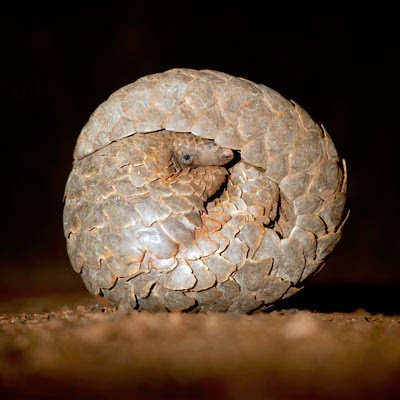Pangolins: Scales of Power
As a child, I remember summers wandering the yard in search of potato bugs. I would live rocks, logs, and move dirt around hoping to catch one of these grey little bugs. I would grab one and place it in my palm. Acting in self-defense, the potato bug would roll itself into a tiny ball. I loved watching this thing completely transform itself from flat and mobile to round and contained. It was magic. How could something be so evolved to know that I was a threat and that the only way to protect itself was to roll up in a ball?
As I began my research on pangolins, I recognized that their defense mechanism was almost identical to the potato bugs I searched for so many years ago. They have short legs and roll up in a ball when threatened. The differ in their clawed front feet which make them slow and unable to outrun predators (lions, tigers, leopards and hyenas). The species wouldn't have survived if they weren't able to adapt to protect themselves from these predators. Rolling up in a tight ball, similar to potato bugs, the pangolin then has scales to shield them from gnashing teeth. No, the pangolin isn't a fish or reptile. It is a mammal with scales - strong, fingernail-like scales (their scales are made of keratin, the stuff your fingernails are composed of).
Another fantastic example of evolution lies in the function of the pangolin's scales. Their diet is comprised of ants and termites. When they nuzzle into a termite nest, the insects try and protect themselves by biting their predators. The pangolin's scales lift to allow the termites in (giving the termites false hope in biting) and then close, killing the termites. After their meal, the pangolin heads to water. They again lift their scales, bringing water in. The water and dead termites act as an exfoliant, cleaning and ridding the pangolin of dust and dirt.
Their taste for ants and termites is satiated by using their long tongue, similar to an anteaters, to extract their insect meal.
When reading about pangolins, who they are as a species and how they have evolved, I think of my potato bug exploring days. I would love to be able to have a night spent tracking and observing these fascinating, nocturnal pangolins much like I did with potato bugs as a child. If we continue to illegally poach and sell, I fear that little dream of mine will no longer be possible.
Sources:
http://pangolins.org/2011/11/01/pangolins-natural-pest-controllers-and-soil-caretakers/
https://bioweb.uwlax.edu/bio203/s2012/grosshue_crai/adaptation.htm
http://www.edgeofexistence.org/mammals/species_info.php?id=1410
As I began my research on pangolins, I recognized that their defense mechanism was almost identical to the potato bugs I searched for so many years ago. They have short legs and roll up in a ball when threatened. The differ in their clawed front feet which make them slow and unable to outrun predators (lions, tigers, leopards and hyenas). The species wouldn't have survived if they weren't able to adapt to protect themselves from these predators. Rolling up in a tight ball, similar to potato bugs, the pangolin then has scales to shield them from gnashing teeth. No, the pangolin isn't a fish or reptile. It is a mammal with scales - strong, fingernail-like scales (their scales are made of keratin, the stuff your fingernails are composed of).
Another fantastic example of evolution lies in the function of the pangolin's scales. Their diet is comprised of ants and termites. When they nuzzle into a termite nest, the insects try and protect themselves by biting their predators. The pangolin's scales lift to allow the termites in (giving the termites false hope in biting) and then close, killing the termites. After their meal, the pangolin heads to water. They again lift their scales, bringing water in. The water and dead termites act as an exfoliant, cleaning and ridding the pangolin of dust and dirt.
Their taste for ants and termites is satiated by using their long tongue, similar to an anteaters, to extract their insect meal.
When reading about pangolins, who they are as a species and how they have evolved, I think of my potato bug exploring days. I would love to be able to have a night spent tracking and observing these fascinating, nocturnal pangolins much like I did with potato bugs as a child. If we continue to illegally poach and sell, I fear that little dream of mine will no longer be possible.
Sources:
http://pangolins.org/2011/11/01/pangolins-natural-pest-controllers-and-soil-caretakers/
https://bioweb.uwlax.edu/bio203/s2012/grosshue_crai/adaptation.htm
http://www.edgeofexistence.org/mammals/species_info.php?id=1410



Comments
Post a Comment
Let your knowledge, ideas, and innovation be heard. Tell us what you think and know about this topic.